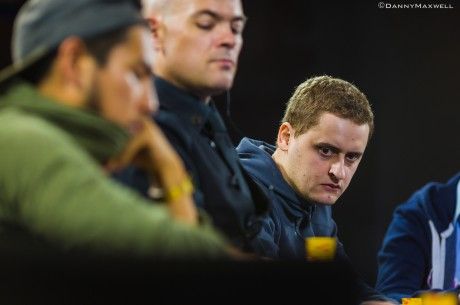Thinking Poker: How Preflop Play Affects Postflop Action

Last week I wrote about how correct aggression and long pot odds we find in tournaments mean you have to play more downright bad hands, often from the big blind, and how you have to think about your opponents playing bad hands, too.
Today I want to discuss one more hand that from that same European Poker Tour Vienna Main Event final table �� one occurring just a few minutes after the one discussed last time �� illustrating another important lesson about how preflop play can affect postflop action.
The blinds were again 40,000/80,000 with a 10,000 ante, and with seven players still left that made for a preflop pot of 190,000. Anthony Ghamrawi opened for 165,000 again, this time from under the gun (UTG) with K?Q?. Pablo Gordillo, now on the button, called with 3?3?. Oleksii Khoroshenin (pictured) also called for 85,000 more from the big blind with A?6?.
In a cash game, it is rarely good to call out of the blinds in a three-handed raised pot with Ax6x-offsuit. However �� as I was discussing last week �� tournaments are different, and in this case when you��re getting better than 6-to-1 pot odds and closing the action, such a hand becomes unfoldable. Khoroshenin and Ghamrawi both had over 5 million in their stacks, Gordillo slightly less (between 4 and 5 million), and Khoroshenin��s call made the pot 605,000.
The Flop
The flop came A?J?8?. Khoroshenin began by checking. Although some strong players might lead out here with Khoroshenin��s hand, I imagine that many good players would check all their hands in this situation. Ghamrawi �� with a gutshot Broadway draw, the second-nut-flush draw, and the betting initiative �� made a continuation bet of 235,000, and Gordillo quickly folded.
Gordillo��s disciplined play is correct against most aggressive players. If your opponents will not let you get to showdown often enough when your baby flushes or unimproved threes are the best hand, it��s hard to turn a profit in this three-handed pot. Khoroshenin then called the 235,000 with his top pair. Again, this is a good and standard play, but it��s useful to think about how Khoroshenin��s preflop decision affected his flop decision.
Here it��s important that Khoroshenin figured to have called from the big blind with many more bad hands before the flop, meaning that his range now included many more one-pair hands. Against a UTG raiser and a button caller, the big blind would have been playing many fewer unsuited and unpaired hands. That means offsuit hands like Ax6x, Ax3x, Jx8x, and 9x7x were possible holdings for Khoroshenin here, but would be improbable in the analogous cash-game situation.
There were at least two important consequences of this preponderance of one-pair hands. One is that Khoroshenin��s hand, after he called, looked something like what it actually was �� that is to say, he figured to have a lot of unpaired hands that made a pair on the flop. (Some of these hands would also have had one-card flush draws of varying quality.) A second consequence is that a weak unsuited AxXx-hand was better than many other hands Khoroshenin could have had, in particular better than many of those junky JxXx- and 7xXx-hands that would have paired the flop.
Keeping track of how good your hand is relative to other hands you could plausibly have is an important poker skill �� the better your hand is by this measure, the less likely you should be to fold (other things being equal). For this reason, the extra (and bad) hands that Khoroshenin was correct to play before the flop made a big difference after the flop.
The Turn
The 5? came on the turn. Khoroshenin checked again, and this time Ghamrawi checked behind.
Ghamwari��s checking has clear advantages: it kept him from putting in money without a pair against what was very likely a stronger hand, and it guaranteed that he would see the river with his strong drawing hand.
There are some reasons to bet in this situation, though. As the UTG raiser, Ghamrawi could have represented many top pairs and other strong hands, so betting would have put Khoroshenin in a tough spot if he had held a hand like 9?7? or J?10?.
Especially given that K?Q? often has many outs even if it gets called, I would have often followed through on the turn in Ghamrawi��s spot. Having a stronger preflop range matters even if you don��t make a strong hand: it can also create good bluffing opportunities. And all those bad hands that Khoroshenin might have had made Ghamrawi��s UTG raising range that much stronger.
The River
The Q? completed the board, and both players checked again. Both checks are reasonable. In particular, Ghamrawi could have expected both for the river queen to have given him the best hand fairly often and for Khoroshenin to have been disinclined to fold hands better than a pair of queens (for reasons I discussed above).
As it turned out, there wasn��t much postflop action in this three-way pot �� just a continuation bet and a call on the flop, then checks from the two remaining players on the turn and river. Even quiet hands, however, often involve important strategic lessons, and here we have seen again that the big blind��s preflop decision can significantly affect postflop action in many tournament hands.
Be sure to check out Nate and Andrew Brokos on the Thinking Poker podcast, and for more from Nate visit his blog at natemeyvis.com.
Get all the latest PokerNews updates on your social media outlets. Follow us on Twitter and find us on both Facebook and Google+!








